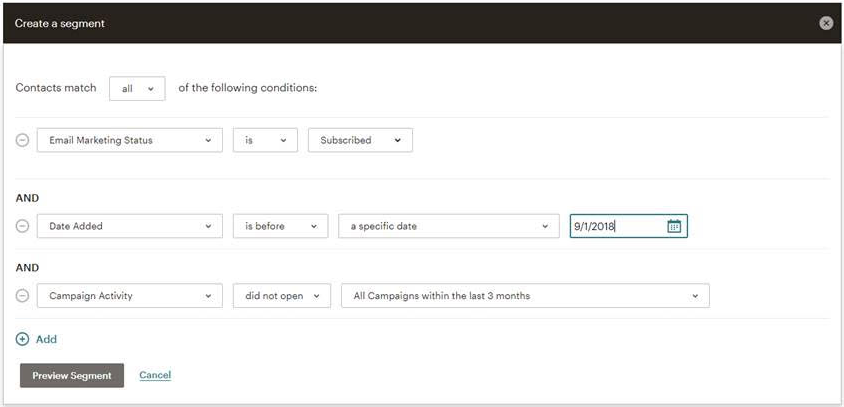Reducing Mailchimp Subscribers Means Reducing Your Costs

The Power of Automated Campaigns
Whether you’re working on audience development to target lapsed customers like Hertford Theatre and Watermans Arts Centre, or you’re looking to drive customer loyalty like Kings Theatre in Portsmouth, email automation is a flexible and rewarding tool for any arts organisation.

Recently we released a white paper on Automation to highlight the incredible results Ticketsolve customers who use MailChimp receive through automation campaigns. If you’re looking to get started, get in touch to get your hands on our whitepaper for some inspiration.
But before you jump into automation, it is a good idea to step back, and think more strategically and think about how your data can help you get more ROI. You might be wondering why it matters after all automation should fix all manner of ills right?
There is no denying the power that automation can bring to your organisation. Not only can automation reduce the time you need to work on and maintain campaigns, it can also enhance and increase the communication between you and your various audience segments.
But organising and implementing multiple mailout campaigns can be costly. Perhaps automation is a project which your team would love to get their hands on, but you’re working on a tight MailChimp budget? Or maybe you overspent on MailChimp in the last quarter with all of the festive hype? These barriers can cause major blockers when it comes to starting a new automation campaign.
This is exactly why we need to make sure we are hitting the correct segments in our email lists. We need to take a closer look at MailChimp Campaigns and how to get the most from Mailout Lists.
Komedia Brighton Uses Data to Create Targeted Campaigns and Improve Open Rates
We recently met with the team at Komedia Brighton to conduct a review of their subscribers’ activity as part of a wider project involving the implementation of automated campaigns. While analysing subscriber activity over the past 12 months, it really struck us that some campaigns had lower than expected engagement levels. We’re not trying to fool anyone, this is not unusual, particularly when lists can be very old and may contain long since abandoned accounts, as Komedia’s did. This is something that our team are extremely conscious of even within our own MailChimp campaigns, it’s an obstacle that affects every organisation but with a very large list, of over 60,000 subscribers and the associated monthly costs, we knew that this warranted further investigating. So we dug a little deeper.

Segmenting MailChimp Lists to Identify Inactive Subscribers
MailChimp is a fantastic tool with a number of really helpful and easy-to-follow guides that allows your team to identify which of your subscribers are not engaging with your organisation’s campaigns. It’s simple to identify this segment based on different reports such as the number of campaigns the subscriber received or the length of time they are subscribed. From these reports, you can then further segment your subscribers. First, it’s worth understanding how Mailchimp determines levels of engagement with your campaigns and the vocabulary they use to define engagement. They have a great article about it posted online here.
It’s a waste of resources to keep inactive subscribers on engaging lists. We need to understand how they react to our communication and what they like (and want) to hear from us. With this in mind, the first segment which Komedia Brighton contacted were subscribers who had not opened a campaign in 3 months and who were subscribed to their campaigns for more than 6 months. Komedia wanted to offer this segment the opportunity to update their preferences or the chance to unsubscribe. This segment list looks like this:

Did you know that you can identify your subscribers with this level of detail? If not, that’s ok! There’s a lot more information available to get you up to scratch on identifying inactive subscribers here.
Re-Engaging with a Short, Sweet and Simple Message
Now let’s get into the tricky bit and consider that if these subscribers have not engaged with or opened past campaigns, how were the team at Komedia Brighton going to demand their attention this time? How could their team encourage subscribers to open this particular email? Their team wrote an attention-grabbing subject line in hopes of their email being noticed in their subscribers’ busy inboxes. Keeping it short and sweet and playing on the heartstrings of subscribers, Komedia opted for the honest question;
Was it something we said?
Komedia kept the entire campaign short and simple. They were looking for results!
We appreciate all our customers and want to make sure we are sending information that is relevant and only about shows you might be interested in attending. If you would like to update your preference so our emails are more tailored to you then please click below.
If you'd rather not hear from us again (although we will be extremely sad to see you go) click below.
Komedia Brighton’s Strategy: Address the Subscribers Interested in Hearing from Them the Most
Komedia directed this campaign at 54% of their overall subscriber list, from which they received a nice plump open rate of 13.5%. From those subscribers who opened it, 1.3% decided that it was time to unsubscribe.
We are all accustomed to trying to increase our subscribers and make more communication with our audiences, but what if that communication is no longer meaningful or impactful? It then becomes wasteful and this was exactly the approach that Komedia Brighton took with this campaign. They wanted to address their subscribers who looked forward to hearing from them the most.
One month later, Komedia sent a second email to subscribers who had not opened their first email. They kindly explained that they would be removed from the list but also included a call to action with a final chance to stay subscribed to news and events.

Their Team have Experienced Fantastic Results!!
At the end of this automation campaign to reduce mailout costs, 90% of subscribers within the segment had not opened or engaged with either campaign. These inactive subscribers were opted out en masse which then reduced Komedia Brighton’s master list by 45%. Don’t panic!! This is not mailout sabotage. In fact, the results which are going to reveal to you are mailout envy-worthy!!
Komedia Brighton reduced their mailout list to a more targeted audience segment, saving on monthly costs of £130 as well as witnessing better results with their open rates. If we think about what Komedia Brighton would have spent last year with a larger list, they have now an annual saving of over an incredible £1500 in return for a few MailChimp campaigns. Now THAT is time very well spent!!

Ticketsolve Considerations on Open Rates
After a brainstorm with the rest of the team, we’ve pulled together two important considerations regarding open rates.
1) Subscribers may have blockers activated on their browsers making it impossible to track their activity. This means there may be subscribers being reported as not opening campaigns when in fact, they have. They could be clicking through and buying tickets to everything you send but you have no way of reporting on this. By ‘cleaning’ your list you run the risk of removing these subscribers. However, current estimates of online users using browser blockers is 6%.
2) A lot of email clients will automatically add your hard work on campaigns to spam or promotional folders meaning subscribers who may very well want to receive your campaigns, never see your mail.
An Outlook Focused on Results…. And Savings
On a more positive note, should you choose to do something like this with your own subscriber list, you can expect to see a far higher open rate on your campaigns and a reduction in those monthly costs along with a big smile from finance (Yipeee) :)
Take A Look At Other Resources and Handy Tools For More Ideas
There are so many different campaigns through automation which your team can easily implement. Before you trial something it’s important not to be wasteful of resources. Clean up your mailout lists this month and look forward to high open rates along with lots of juicy savings going forward. This means by communicating with those audience members who want your news the most, not only will your message be more meaningful and impactful, but you will also have more resources left in your MailChimp budget to trial and implement powerful automation campaigns. MailChimp has loads of great guides and tutorials so make yourself familiar with them and get going on all the cool things you’ve probably always been meaning to do.
Here are two ‘refresher’ articles which we read frequently. Keeping them bookmarked means that you can access them whenever you have questions regarding MailChimp tracking and open rates.
What open tracking is and how it works
How to resend a campaign to subscribers who didn’t open it

From the results gathered first-hand by the team at Komedia Brighton, the team at Ticketsolve believe that reducing your MailChimp subscribers list to active subscribers have powerful impacts and produce positive results. Komedia used a simple and easy strategy to identify which subscribers were causing them to leak resources.
Don’t forget, if you’re interested in Automated Campaigns or want a copy of the Ticketsolve Whitepaper on Email Automation, get in touch!!
Finally, a big thank you to Cassie and Julie at Komedia Brighton for working with us on this project and allowing us to share it with the Ticketsolve Community :)
Categories
Recent posts
Archive
- December 2025 (2)
- November 2025 (1)
- October 2025 (3)
- September 2025 (1)
- August 2025 (3)
- July 2025 (3)
- June 2025 (3)
- May 2025 (4)
- April 2025 (5)
- March 2025 (5)
- February 2025 (4)
- January 2025 (4)
- December 2024 (3)
- November 2024 (5)
- October 2024 (4)
- September 2024 (7)
- August 2024 (5)
- July 2024 (3)
- June 2024 (3)
- May 2024 (3)
- April 2024 (3)
- March 2024 (4)
- February 2024 (5)
- January 2024 (3)
- December 2023 (3)
- November 2023 (4)
- October 2023 (4)
- September 2023 (5)
- August 2023 (3)
- July 2023 (4)
- June 2023 (4)
- May 2023 (5)
- April 2023 (4)
- March 2023 (4)
- February 2023 (5)
- January 2023 (4)
- December 2022 (4)
- November 2022 (3)
- October 2022 (4)
- September 2022 (5)
- August 2022 (2)
- July 2022 (4)
- June 2022 (5)
- May 2022 (4)
- April 2022 (5)
- March 2022 (3)
- February 2022 (4)
- January 2022 (4)
- December 2021 (2)
- November 2021 (3)
- October 2021 (5)
- September 2021 (4)
- August 2021 (4)
- July 2021 (3)
- June 2021 (4)
- May 2021 (2)
- April 2021 (4)
- March 2021 (5)
- February 2021 (4)
- January 2021 (5)
- December 2020 (4)
- November 2020 (4)
- October 2020 (5)
- September 2020 (5)
- August 2020 (4)
- July 2020 (7)
- June 2020 (5)
- May 2020 (5)
- April 2020 (5)
- March 2020 (8)
- February 2020 (4)
- January 2020 (5)
- December 2019 (3)
- November 2019 (5)
- October 2019 (4)
- September 2019 (4)
- August 2019 (5)
- July 2019 (4)
- June 2019 (4)
- May 2019 (5)
- April 2019 (4)
- March 2019 (4)
- February 2019 (3)
- January 2019 (5)
- December 2018 (4)
- November 2018 (8)
- October 2018 (2)
- September 2018 (3)
- August 2018 (5)
- July 2018 (4)
- June 2018 (4)
- May 2018 (1)
- April 2018 (1)
- March 2018 (3)
- February 2018 (2)
- December 2017 (2)
- November 2017 (3)
- October 2017 (4)
- September 2017 (2)
- August 2017 (1)
- July 2017 (5)
- June 2017 (3)
- May 2017 (2)
- April 2017 (3)
- March 2017 (2)
- February 2017 (3)
- January 2017 (3)
- December 2016 (4)
- November 2016 (1)
- September 2016 (1)
- July 2016 (3)
- June 2016 (1)
- May 2016 (2)
- April 2016 (2)
- February 2016 (1)
- January 2016 (3)
- December 2015 (2)
- September 2015 (1)
- August 2015 (2)
- July 2015 (1)
- June 2015 (2)
- May 2015 (2)
- April 2015 (5)
- March 2015 (2)
- February 2015 (2)
- January 2015 (4)
- December 2014 (3)
- November 2014 (3)
- October 2014 (2)
- September 2014 (3)
- August 2014 (3)
- July 2014 (3)
- June 2014 (7)
- May 2014 (6)
- April 2014 (3)
- March 2014 (2)
- February 2014 (1)
- January 2014 (3)
- December 2013 (1)
- August 2013 (1)
- June 2013 (1)
- April 2013 (1)
Sign up for regular updates


